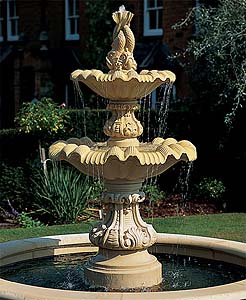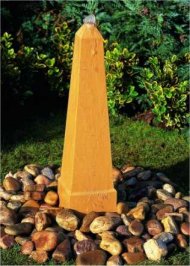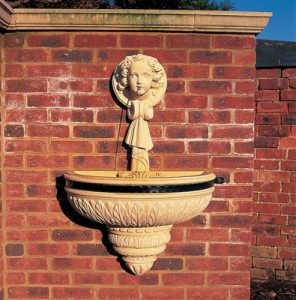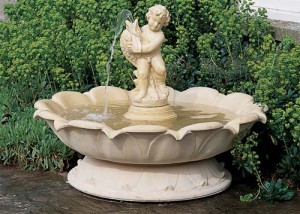Types of Garden Fountains
Gardens are a place to relax and take in the beauty of nature and the outdoors. It takes a considerable amount of time and effort to design and implement a complete garden design, but the time and money spent can be well worth it if you spend a considerable amount of time relaxing, entertaining and working in your garden. A well designed landscape can be a great investment as it can raise the market value (known as the “curb appeal” for front yard gardens) of a property. Adding plants, containers, sculptures, paving and water features are just a few of the ways a landscape’s design can be enhanced. This article focuses on the function and use of 5 different types of fountains.
When a water fountain is added to a garden, it changes it’s entire look and feel. What was at first a very ordinary garden can be transformed into an outdoor oasis. The sound of flowing water has a relaxing effect and it can also attract birds and other wildlife, changing the atmosphere entirely. A fountain also becomes a focal point of any backyard or garden.
Garden fountains are available in varying sizes, materials, and styles. They can be wall-mounted, tiered, disappearing, or freestanding. They can be customized according to the space where they are to be installed, your budget, and the amount of maintenance you are willing to perform. Many fountains come completely prefabricated.
Landscapers generally follow a rule when installing fountains. They typically make use of two fountains, one big and one small. The bigger fountain is the focal point of the garden and the smaller one is the accent element. Another consideration is the type of garden where the fountain is to be installed. The professionals at Beyond The Veranda can provide you with tips and ideas for adding the right fountain to your garden. Call or email us today to get help with your landscape design or installation project.
Here are 5 different types of garden fountains:

Tiered Fountain
Tiered fountains are very popular and have been used in gardens for years. These tiered fountains are popular in Mediterranean countries like Spain and Italy. They are installed in the courtyards and plazas. The design of a tiered fountain can be simple or complex like carvings depicting people, animals, and others.
Tiered fountains look great in a traditional or classical landscape setting. The fountain should look as if it has been in place for years and the color of the fountain should blend with the paving.

Disappearing Fountain
This water feature is also known as a pondless fountain. The water reservoir in this type is hidden beneath the ground. This feature looks good when it is positioned close to a patio or path, as it adds an attractive appearance and sound to the area. Popular styles include millstones, ceramic urns, granite columns, and natural looking waterfalls, among others.
A disappearing fountain can be an ideal choice for your gardens for a number of reasons including:
- Since the water reservoir is underground and there is no open water pond or basin, there is no drowning risk. It is therefore safe for children.
- As the water body is underground, the water does not evaporate. Therefore, less water is used compared to traditional fountains.
- It requires very little maintenance. Dirt, debris and leaves cannot enter the reservoir and the sun cannot cause algae growth.
- It takes up a very little space and can be installed almost anywhere. It is most suitable for small patios and backyards.
Japanese Fountain
Every Japanese garden has a water fountain. It symbolizes spiritual and physical cleansing and therefore, they are located at the entrance of a Japanese temple or home. Japanese fountains typically have simple designs, with the focus on the water rather than the basin.
A water fountain with a bamboo spout can be installed. Water trickles from this bamboo spout into the basin of the fountain, which is usually made from stones. It should have jagged edges and should look old and weathered down by outdoor elements. This fountain typically appears to be in harmony with nature, hence, it is installed among rocks and surrounded by evergreen plants and ferns. In short, this fountain is more than just an ornament or décor.
Another idea is to install a stone fountain on a gravel bed, and surround it with live bamboo and rocks. With the passage of years, moss grows on the stone, and it begins to look more like part of the landscape.
People who have a plenty of open space can consider having a big water feature. They can create a meandering pond or stream and add fish to it (such as a koi pond).
It is not necessary to have water present in a Japanese fountain. Many Japanese gardens use sand, gravel, or stones that represent water. These gardens can also have flat stones from the river, which are laid together tightly, making it look like a moving stream of water.
Wall Fountain
A wall fountain looks perfect in a courtyard or a small patio as it gives the sense of relaxation. This fountain does not take up too much space and can be customized to fit on a particular wall. It requires a spout, water basin, internal tubing, and a pump. It can be either freestanding or mounted. Its styles include traditional, modern, antique or Asian.
A freestanding wall fountain, also known as floor fountain, is usually quite large. The basin of this fountain is placed on the ground.
A wall mounted fountain on the other hand, is integrated onto an existing wall or built into a new wall. This fountain adds a cohesive look, which makes it look like a part of the landscape instead of an added feature. This natural look is quite the work of art.
Self-Contained Fountain
Self-contained fountains are popular because they are affordable and can be installed quite easily. They contain all the working parts including the plumbing and pump required to function. “Self-contained” can also refer to fountains that have their own water reservoir and therefore don’t need to be placed in a pond or pool.
These fountains are great for decks and patios as installation is relatively quick and easy and they don’t require any major construction. This also makes it a simple task to move the fountain to another location.
To install the fountain, the landscaper will first ensure that the land where the fountain is to be placed is level. If the ground is uneven (which is often the case on a lawn or garden), then he will level and compact it. The fountain will then be placed, and the water will be added to it. Finally, it is connected to a power source such as a solar panel, batteries, or an electrical outlet.
A self contained fountain is very convenient as it does not require external piping, plumbing, or connection to a body of water. They can be placed anywhere in the garden, though they are often used as a centerpiece or focal point. They can be made from cast stone, metal, ceramic or fiberglass, among other materials.
Be sure to consult a landscaping professional if you need advice or help with getting the right look for your garden.



Comments are closed.